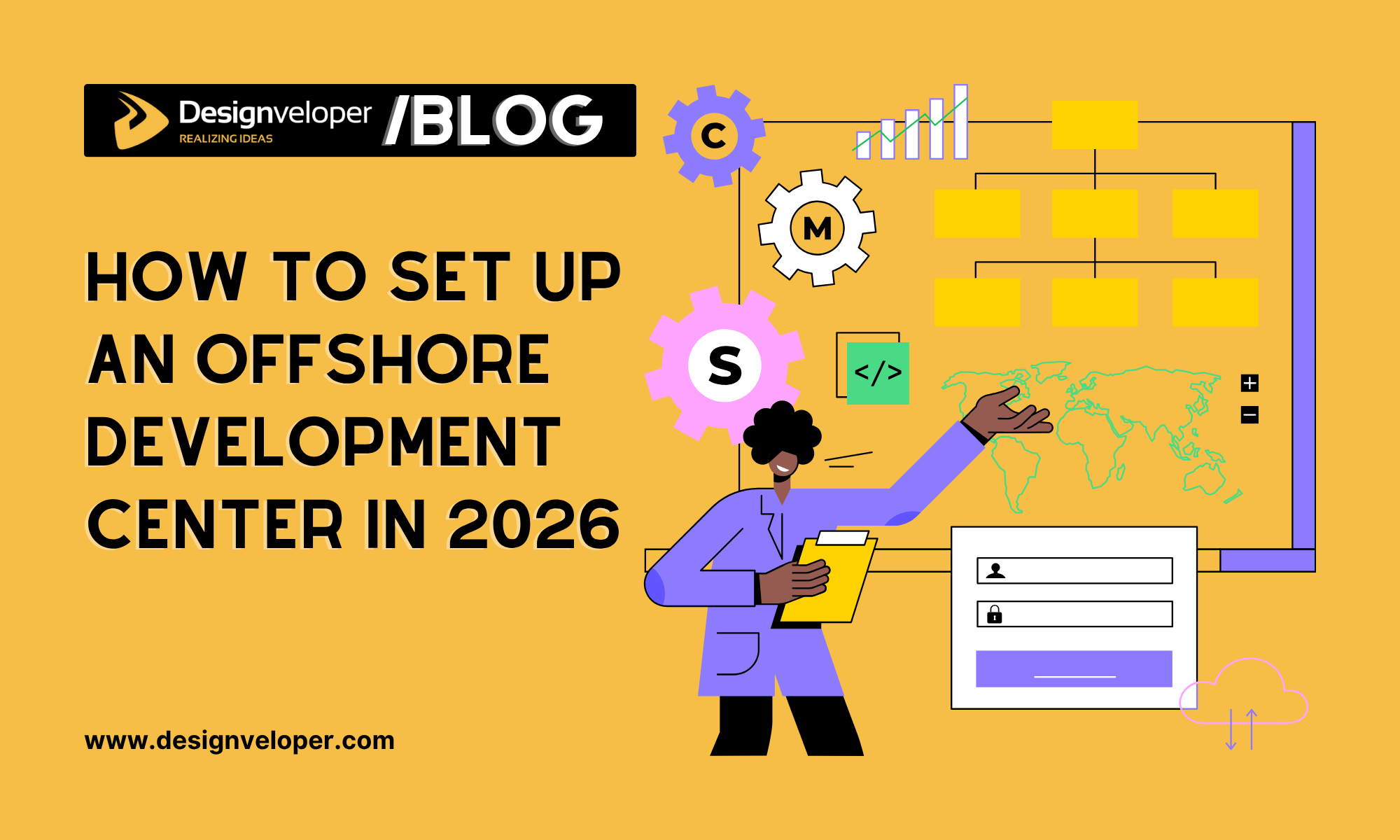


Remember when companies hired developers exclusively within their city limits, and remote work seemed like something out of a sci-fi novel? Back then, we’d watch The Office and laugh at how perfectly the writers captured your company’s vibe.
In 2026, the offshore development center model is experiencing a real renaissance. After the pandemic-era boom of remote work and chaotic freelancer hiring across the globe, companies are returning to a more strategic approach to building unified teams, but without limiting themselves to their city boundaries.
Why now? First, technology allows us to manage teams just as effectively as if they were sitting in the next office over. Second, the global talent market has become more accessible, and companies have realized that the best developers can be found anywhere. Third, economic realities force us to seek a balance between quality and cost, and an offshore software development center provides exactly that balance.

In short, it’s your own team of developers physically located in another country but working exclusively for your business. Don’t confuse it with outsourcing, where you “buy” services from an agency that might simultaneously work for dozens of clients. And it’s not simple outstaffing, where you borrow a few specialists temporarily.
An ODC (Offshore Development Center) is like opening a branch of your company, just without the need to figure out local laws, office rental, and HR processes yourself. For example, a US company might decide to create an offshore development center in Poland. They get a team of 20 developers, QA engineers, project managers, all working under their brand, integrated into their processes, using their tools. But the company doesn’t spend time registering a legal entity in Poland, doesn’t search for office space in Warsaw, and doesn’t deal with Polish labor laws.
The difference from other models is simple: outsourcing is “do this for me,” outstaffing is “lend me specialists for a while,” and an offshore software development center is “build me a team that becomes part of my business.

The main reason companies choose this model is scalability. Need to quickly expand your team from five to fifty developers? With an ODC, it’s realistic. Want to save 40-60% on salaries without losing quality? Totally achievable if you choose the right location.
But before diving into details, let’s honestly compare ODC with other popular models. Because often companies choose not the best option, but simply the first one that came to mind.
| Criterion | Freelance | Outsourcing | In-house hiring | ODC |
| Team control | Minimal | Medium | Maximum | High |
| Speed to start | Very fast (days) | Fast (weeks) | Slow (months) | Medium (1-2 months) |
| Cost | Low per hour, but unpredictable | Medium-high | Highest | Medium |
| Scalability | Difficult | Limited by agency resources | Very difficult | Easy |
| Long-term loyalty | Virtually none | Low | High | High |
| Company culture integration | None | Minimal | Full | High |
| Legal risks | High | Low | Low | Low (with partner) |
| Access to top talent | Limited | Depends on agency | Limited by location | Global |
What becomes obvious from this table? Freelance is quick and cheap for short-term projects, but a nightmare for anything serious. Outsourcing is great, but the team works for the agency, not for you. In-house hiring is ideal, if not for the cost and limitations.
With an offshore software development center, you get control almost like in-house hiring, but at a reasonable price. The team works for you, integrated into your processes, loyal to your brand. At the same time, you have access to a global talent pool and can scale the team without recruitment headaches.
Honestly speaking, setting up an offshore software development center isn’t for everyone. If you need a team for two months for a simple project, get freelancers or outsourcing. But if you’re building a long-term strategy, planning to scale, and want real control over your team, ODC gives the best balance between control, quality, and cost.

Okay, you’ve decided that ODC is what your business needs. Where to start? Let’s break it down in order.
First question: why do you need an ODC? If it’s simply “we want to save money,” that’s a bad answer. Good reasons include: scaling a product team, expanding R&D capabilities, gaining access to specific tech talents (like AI/ML specialists), ensuring 24/7 product support.
Second question: which model to choose? You can open your own office, the most expensive and slowest option, but with maximum control. Or work through a partner who handles legal, HR, and operational matters, faster, cheaper, but you need a reliable provider.
In 2026, the choice is huge. Europe includes Poland, Romania, Ukraine, Portugal. Pros: close time zones (not so much for the US), high technical level, English proficiency, cultural proximity to the West. Latin America covers Argentina, Mexico, Brazil. Perfect for American companies: convenient time zones, decent English level, loyal business environment. Asia offers India, Vietnam, Philippines. Cheapest, huge talent pools, but time zones are challenging for Europe and the US.
What to look for when choosing: average developer salaries, tax conditions, political stability, IT education development, internet quality (yes, in 2026 this still matters), population’s English proficiency.
You can’t do without lawyers here. Need to decide: register a legal entity or work through an employer of record (EOR)? How to pay taxes, in your country or in the ODC country? How to structure contracts with employees so they comply with local legislation?
If you work through a partner, they take these headaches on themselves. If you go solo, prepare for several months of bureaucracy and considerable legal and accounting expenses.
Setting up offshore development center is impossible without the right hiring strategy. Start with key roles: a team lead who understands your culture and can bridge between you and the local team, several senior specialists who set the quality standard.
Recruiting abroad has its peculiarities. The local market might work differently: somewhere you need to offer sick leave, somewhere relocation bonuses (even within the country), somewhere additional social packages. Study what’s normal in your chosen location. If you prefer to delegate the entire process, dedicated agencies exist that specialize in setting up and running your offshore development center, such as Newxel.

The most difficult step. How do you make a team thousands of kilometers away feel like part of your company? Regular video calls, shared virtual events, transparency in communication, uniform development processes (Scrum, Kanban, doesn’t matter, the main thing is consistency).
KPIs should be clear and measurable: not “work fast,” but “close 90% of tickets per sprint,” not “be creative,” but “propose at least two new ideas per quarter.” Culture of trust is the foundation: if you start micromanaging every step, ODC isn’t for you.
In 2026, this isn’t just a checkbox on the list, it’s a critically important part. VPN for all employees, two-factor authentication, data encryption, regular security audits. If you work with customer personal data, you need to comply with GDPR (for Europe) or equivalents in other regions.
Technical infrastructure: cloud solutions (AWS, Azure, Google Cloud) allow teams to work with the same tools regardless of location. CI/CD pipeline should be set up so any developer can deploy code without hassle.
The world doesn’t stand still, and the approach to offshore development center is also evolving. What changed in 2026?
Creating an offshore development center in 2026 isn’t just a trend or temporary fashion. It’s a strategic decision that can take your business to a new level: give access to global talent, reduce costs, accelerate product development. But it’s also a challenge: you need to choose the right location, establish processes, build a culture of trust.
If you approach this seriously, with a clear plan, reliable partners, and focus on long-term perspective, ODC will become not just “a team somewhere out there,” but a full-fledged part of your business. Creating an ODC is like building a spaceship: it’s only difficult the first ten minutes after launch. After that, the trajectory is set, and you’re flying toward your goal.





